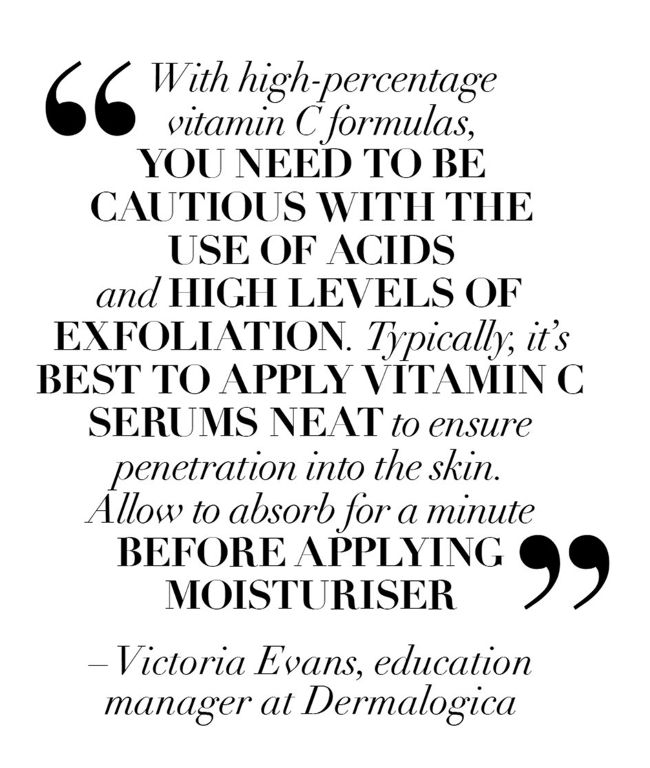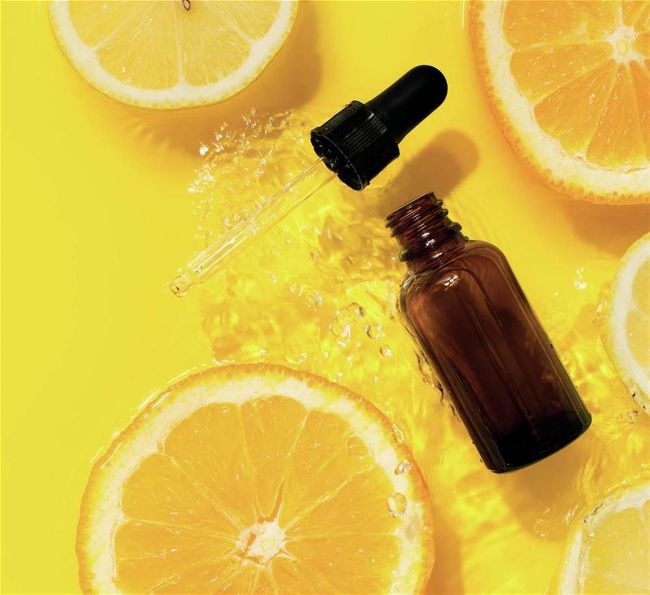VITAMIN SPECIAL
SPOTLIGHT ON... VITAMIN C
Known as a potent antioxidant that neutralises free radicals and promotes collagen synthesis, vitamin C is one of the most-used skincare ingredients out there. Amanda Pauley outlines what makes it a skincare staple…
Why the hype?
As one of 2021’s trendiest ingredients – it was the second most searched-for skincare ingredient on Google last year according to data from comparison site Skincare Hero – it’s no wonder clients are curious about vitamin C. “It is an essential ingredient for the health of our skin due to its high antioxidant power,” says Gina Baker, training manager at Germaine de Capuccini. “It also increases the synthesis of collagen, which aids the repair of skin, making it essential in preventing scarring. It also prevents transepidermal water loss, making it ideal to improve skin hydration.”
It can also help firm, brighten, correct damage and encourage healthy skin function. As the human body can’t synthesise vitamin C, clients need to obtain it from their diet, “and we can only store it for a short period before the body eliminates it due to it being a water-soluble vitamin,” explains Victoria Evans, education manager for pro brand Dermalogica. “To get results in the skin, topical application is key, and daily application is needed.”

How does it work?
Vitamin C is a potent antioxidant that neutralises free radicals, which are generated by our bodies when exposed to certain conditions, such as UV rays and pollution. “Free radicals can negatively impact DNA, lipids and proteins, causing a variety of diseases, damaging the cells and disrupting the skin’s ability to repair itself, slowing collagen production,” says Evans. This can result in wrinkles, dullness and uneven skin tone. Applying vitamin C can help skin cope with oxidative stress. “It regulates synthesis of collagen by supporting the hydroxylation of collagen molecules, which is necessary for its extracellular stability and support of the epidermis. It also increases the proliferation rate of fibroblasts (collagenproducing cells) –a capacity that is decreased with age,” she adds.


What are the different forms?
• Ascorbic acid – The most potent form. “It is very unstable, reacting to heat and light. It needs to work at a lower pH to be effective, which increases the chance of irritation,” says Baker.
• Magnesium ascorbyl phosphate –A watersoluble form ideal for brightening, “but it is not as effective as an antioxidant,” adds Baker.
• Sodium ascorbyl phosphate – “Much more stable in formulations and proves to be kinder on the skin,” explains Baker.
• Ethyl ascorbic acid – Stable in both oil and water, it “works well as an antioxidant; however, its collagen-boosting abilities are not as effective,” she adds.
• Ascorbyl glucoside – Water soluble and “although not as potent, it still proves effective for increasing collagen production and inhibiting melanin formation,” says Baker.
• Ascorbyl palmitate –A fat-soluble derivative that’s not as widely used because it lacks greater effectiveness for brightening and wrinkle reduction.
• Tetrahexyldecyl ascorbate – An oil-soluble form that “penetrates the skin deeper and faster than other forms”, adds Baker.

Can vitamin C’s stability effect efficacy?
Delivery of topical vitamin C into the skin is dependent on how stable the formulation is and how susceptible it is to being oxidised. “Traditional forms of vitamin C – e.g. ascorbic acid – are easily oxidised upon exposure to air, heat or water, degrading the formula’s efficacy. This is evident when your product turns brown, or starts to smell funky,” explains Evans. “These ‘pure’ forms are watersoluble and highly acidic, meaning they have the potential to cause skin irritation in higher percentages, which are often used to compensate for the high rate of instability within a formula.”
Ultra-stable forms ensure vitamin C is delivered to the skin where it’s needed. Vitamin C can be stablised using various compounds, such as oil-soluble forms or by encapsulation. “Newer technologies have advanced this, ensuring good shelf life and effectiveness as actives reach the target biological site before degrading,” she adds.
WHAT ARE THE DOS AND DON’TS OF USING IT?
The pros recommend clients use vitamin C once per day. However, they should avoid using vitamin C with benzoyl peroxide, AHAs, BHAs or retinol. “Not only do they cancel each other out, but they can cause skin irritation and redness,” explains Baker.
“Instead, get clients to use vitamin C in the day and one of these other ingredients at night.”